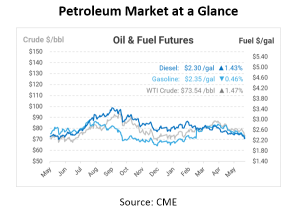
What’s That: Neoflo 4633
Have you been looking for a cleaner alternative to diesel-based drilling fluids? Well, look no further because Neoflo 4633 is here to help. This fluid has top-notch benefits and can change the game in terms of drilling productivity and environmental friendliness. Today’s What’s That Wednesday is covering all things Neoflo 4633 and the benefits of transitioning to this synthetic fluid for your operations.
What is Neoflo 4633?
Neoflo 4633 is an innovative synthetic drilling base fluid derived from natural gas designed for both traditional land-based and unconventional deep-water drilling applications. As an alternative to traditional diesel oil-based drilling fluids, Neoflo 4633 stands out for its environmental friendliness and high performance in drilling operations. It is extensively utilized as a nonaqueous base fluid in water and invert emulsion drilling muds, as well as in hydraulic fracturing fluids and production chemicals within the upstream oil and gas sector. Neoflo is categorized as a synthetic gas-to-liquids base drilling fluid because it is derived from the reaction of a purified feedstock, rather than from highly refined or processed mineral oils, which originate from the distillation or refining of crude oil.
Why is Neoflo 4633 Important to the Oil and Gas Industry?
The oil and gas industry relies heavily on efficient and effective drilling operations to meet global energy demands. In the United States, there are hundreds of onshore drilling operations that extract these resources. Drilling fluids are crucial for providing lubrication, aiding in cuttings extraction, and ensuring the stability of the drilling operation. Traditionally, these fluids have been predominantly oil-based, with diesel as a common choice. However, Neoflo 4633 offers a superior alternative with multiple benefits:
Environmental Safety: Due to its derivation from clean natural gas, it is virtually free of aromatics and lacks contaminants like sulfur and amines. It is readily biodegradable and reduces the need for harsh disposal methods by allowing the use of microbes to degrade residual oil on drill cuttings.
Improved Worker Safety: The fluid is odorless, has low volatility, and has a high flash point, which contributes to safer working conditions by reducing the risk of fire and lowering vapor exposure.
Enhanced Efficiency: Field trials have demonstrated that Neoflo 4633 enhances drilling efficiency.
Transitioning to Neoflo 4633
Drilling fluids are either water or oil-based, which, when formulated, are used by well operators in drilling for oil and gas. The horizontal section or ‘lateral’ of each well is typically drilled with oil-based fluid consisting of base oil that makes up most of the volume, as well as barite, clay, and chemical additives. Thanks to advances in drilling technology and drilling fluid formulations, diesel is no longer the only option for base oil – nor is it the best. Neoflo 4633 is odorless, has low volatility, and has a high flash point for improved worker conditions. It is readily biodegradable, allowing operators the option to use microbes to reduce the oil remaining on drill cuttings to acceptable levels and lower liability and disposal costs.
Case Study on Savings
The simpler, purely paraffinic nature of Neoflo 4633 offers several advantages in drilling. In a 100-well field trial, there was a 10-15% improved rate of penetration, lower mechanical specific energy for longer lateral operations, and longer mud motor runs requiring fewer trips in and out of the hole. Neoflo 4633 was shown to save over $100,000 per well compared to diesel from less base oil consumed, faster casing runs, less drilling time, and less non-productive time. Operators using Neoflo 4633 have clearly realized these benefits. Also, aside from the financial savings, there are health and environmental benefits through the absence of aromatics, leading to lower vapor exposure and lower pollution risk as well.
Although the up-front unit cost of Neoflo 4633 is a bit higher than that of diesel, this additional cost is more than offset by 5 – 20 times due to the operational and HSE performance benefits. The total cost of ownership in drilling the well should be considered, as that is the cost that affects the profitability of a shale project.

This article is part of Daily Market News & Insights
Tagged: DRILLING, energy, fluid, Neoflo 4633, synthetic
MARKET CONDITION REPORT - DISCLAIMER
The information contained herein is derived from sources believed to be reliable; however, this information is not guaranteed as to its accuracy or completeness. Furthermore, no responsibility is assumed for use of this material and no express or implied warranties or guarantees are made. This material and any view or comment expressed herein are provided for informational purposes only and should not be construed in any way as an inducement or recommendation to buy or sell products, commodity futures or options contracts.





